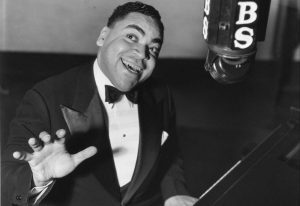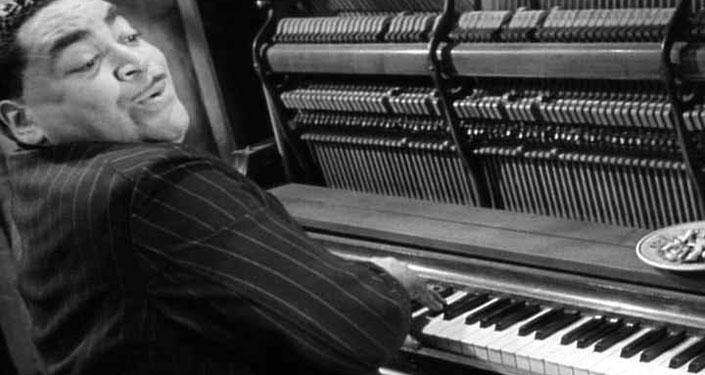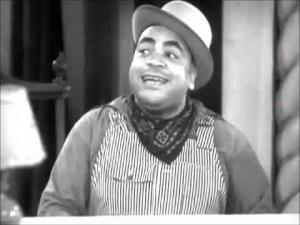 Most of the major jazz musicians excelled in one or two areas. For example Jack Teagarden, the subject of last month’s Profiles In Jazz, was a great trombonist and singer. The remarkable Duke Ellington was brilliant in four different ways, as composer, arranger, bandleader and pianist. However Fats Waller topped them all with his contributions in five different but overlapping areas.
Most of the major jazz musicians excelled in one or two areas. For example Jack Teagarden, the subject of last month’s Profiles In Jazz, was a great trombonist and singer. The remarkable Duke Ellington was brilliant in four different ways, as composer, arranger, bandleader and pianist. However Fats Waller topped them all with his contributions in five different but overlapping areas.
First and foremost, Waller was one of jazz’s greatest stride pianists, following in the footsteps and eventually surpassing his mentor and idol James P. Johnson. He made the most hyper and virtuosic solo sound quite natural and effortless, as if the music simply flowed out of him. Waller was also jazz’s very first organist. Unlike the other organists of the 1920s and ’30s, he managed to swing the pipe organ, never sounding stodgy or as if he belonged in a movie theatre or playing for roller skaters.
Fats was a major songwriter, starting with “Squeeze Me” in 1918 and composing such songs as “Honeysuckle Rose,” “Ain’t Misbehavin’,” “Keeping Out Of Mischief Now,” “Jitterbug Waltz,” the first anti-racism protest song “Black And Blue,” plus dozens of others. By the early 1930s, Waller had developed into an excellent jazz singer, one who could sound quite touching on “I’m Gonna Sit Right Down And Write Myself A Letter,” could scat very well, always swung, and was an expert ad-libber. And as a comic personality, Waller was nearly unbeatable, satirizing the lyrics of songs, interacting with other singers, and just being a lovable character.
Most remarkable was that Fats Waller did all of this while living a nonstop party full of an excess of liquor, women, food, and music. Although he only made it to 39, Waller lived several lifetimes during those years.
Early Years
Thomas “Fats” Waller was born May 21, 1904 in New York City. He started playing the harmonium when he was five, switching to piano at six. He gained early experience performing in his school orchestra and in church but his childhood was not entirely happy. Waller’s father was a church minister who was quite strict. He wanted his son to only play religious music but Fats was more interested in popular music, ragtime, and the new stride piano style that James P. Johnson was pioneering. After Waller’s mother died, life at home became unbearable. About that time, he met James P. Johnson, began taking informal lessons from him, and he soon moved in with James P. and his wife.
Silent Movie Organist
In 1919, when he was still just 15, Waller began working at the Lincoln Theatre as their house organist, playing for silent movies in a stomping style that must have delighted (or confused) the audience. He found time to give a young Count Basie organ lessons during the shows.
As the 1920s began, Waller’s life was already quite busy. In addition to playing at the Lincoln Theatre, he began making piano rolls (which would eventually total 20), he cut his first solo records in 1922 (“Muscle Shoals Blues” and “Birmingham Blues”), and performed regularly at wild rent parties, sharing the piano bench with James P. Johnson, Willie “The Lion” Smith and other local pianists.
New York Jazz
A fixture on the New York jazz scene throughout the 1920s, Waller accompanied many blues and pop singers on records during 1923-29 including Gene Austin, Rosa Henderson, Alberta Hunter, Sara Martin, and Clarence Williams. He recorded with such groups as the Fletcher Henderson Orchestra (including on “Henderson Stomp,” “The Chant,” and “I’m Coming Virginia”), Johnny Dunn, McKinney’s Cotton Pickers, and the Mound City Blue Blowers.
He teamed up with James P. Johnson, playing organ on selections by the Louisiana Sugar Babes. Waller worked with lyricist Andy Razaf on the shows Keep Shufflin’, Hot Chocolates, and Load Of Coal, productions that resulted in some of his greatest hits. He made his debut at Carnegie Hall in James P. Johnson’s Yamekraw. And during 1926-30, Waller recorded as a piano soloist (including “Handful Of Keys,” “Ain’t Misbehavin,’’ and “Smashing Thirds”), an organ soloist, and at the head of his own hot combos (including on “The Minor Drag” and “Harlem Fuss”).
Fame
Still, as 1930 began, few in the general public were familiar with Fats Waller, but that would soon change as he began to sing and display his abilities as a humorous personality. He had only recorded a solitary vocal in the 1920s (briefly on “Red Hot Dan”) but in 1931 Waller sang on solo piano-vocal versions of “I’m Crazy ‘Bout My Baby” and “Draggin’ My Heart Around,” and on sessions led by Jack Teagarden and Ted Lewis. After visiting France and England in 1932, he began appearing regularly on the radio show Fats Waller’s Rhythm Club. Executives at the Victor label liked what they heard and they signed him to a contract.
Leading his Rhythm, a sextet that often featured trumpeter Herman Autrey, Gene Sedric on tenor and clarinet, and guitarist Al Casey, Waller became world famous. His ability to turn the worst songs into hilarity by satirizing, tearing apart and destroying the lyrics became a unique feature of his records. The party atmosphere of his recordings, which always included bits of his stride piano along with heated ensembles and ad-libbing, made him into a household name.
In the 1930s, Fats Waller ranked at the top among African-American entertainers along with Louis Armstrong, Duke Ellington, Cab Calloway, and Bill “Bojangles” Robinson. Not counting piano solo performances, rare numbers with a big band that he occasionally took out on tours, and alternate takes, Waller recorded 282 selections with his Rhythm for Victor during 1934-42, an average of over 15 78s a year.
Riffing
Music publishers were delighted with the fact that Waller was recording some of their worst numbers, songs that otherwise might never have been documented. Fans were certainly entertained by the outrageous nature of the crazier recordings. Some of the songs were actually good and treated decently by Waller including “A Porter’s Love Song To a Chambermaid,” “How Can You Face Me,” “Believe It Beloved,” “You’ve Been Taking Lessons In Love,” “Got A Brand New Suit,” “All My Life,” “It’s A Sin To Tell A Lie,” and his hit recordings of “The Joint Is Jumping” and “Your Feet’s Too Big.” But even Waller could not save such turkeys as “Us On A Bus,” “My Window Faces The South,” “Why Hawaiians Sing Aloha,” “I Love To Whistle,” “Little Curly Hair In A High Chair,” “You’re A Square From Delaware,” “Eep, Ipe, Wanna Piece Of Pie,” “My Mommie Sent Me To The Store,” “I’m Gonna Salt Away Some Sugar,” and “Abercrombie Had A Zombie!”
Even Waller occasionally became frustrated by the songs he was given to record but most of the time he was able to laugh it off by ripping them to shreds. His recordings sounded like one big party, reflecting his life. His regular radio appearances kept him before the public and in 1935 he appeared in one major production number apiece in the movies Hooray For Love and King Of Burlesque. He stole the show in both cases, performing “Living In A Great Big Way” with Bojangles in the former film and “I’ve Got My Fingers Crossed” in the latter.

In 1941 he made further appearances on film, recording three-minute Soundie versions of “Honeysuckle Rose,” “You’re Feet’s Too Big,” “The Joint Is Jumpin’,” and “Ain’t Misbehavin’” that give one glimpses of what it must have been like to see Waller performing at a party filled with dancers and drinkers.
During 1938-39 Waller visited England twice where he was taken a little more seriously as an artist than the US. In addition to hotter numbers, he had opportunities to record spirituals on organ and he wrote and recorded the six-part “London Suite,” the most extensive work of his life.
Last Years
As the 1940s began, Fats Waller’s popularity and lifestyle were unchanged at first. He could have coasted but was getting a little restless and searching for new musical horizons. On January 14, 1942 he performed what was supposed to be a concert of “serious music” at Carnegie Hall. Unfortunately, Waller was nervous, drank too much, and the results were mixed. All that exists on record are a couple of jam session numbers with Eddie Condon.
Waller recorded his last two sessions with his Rhythm in 1942 before breaking up the group. His last success in that format was the debut of his “Jitterbug Waltz” which is considered the first major jazz waltz. He had his best film appearance in 1943’s Stormy Weather, accompanying singer Ada Brown on “That Ain’t Right” and performing “Ain’t Misbehavin’” in typically exuberant fashion.
By then, Fats Waller was performing as a solo act and writing the music for the musical Early To Bed. One wonders what the future would have held for him had he lived for a couple more decades. What would Waller have done in the era of bebop and r&b, and how would he have handled rock ’n’ roll? He would have been a natural for TV but how would his joking around have been received during the Civil Rights era? Would he have evolved with the times, led an all-star group on the level of Louis Armstrong, or would he have faded away?
Unfortunately we will never know. His years of partying and hard living caught up with him. While on a train traveling to New York from Hollywood, he caught pneumonia and passed away near Kansas City on December 15, 1943.
Fats Waller’s musical legacy is still with us on hundreds of recorded performances, around half an hour of film footage, and in his classic songs. He remains a symbol of jazz at its most infectious, swinging and fun.
Since 1975 Scott Yanow has been a regular reviewer of albums in many jazz styles. He has written for many jazz and arts magazines, including JazzTimes, Jazziz, Down Beat, Cadence, CODA, and the Los Angeles Jazz Scene, and was the jazz editor for Record Review. He has written an in-depth biography on Dizzy Gillespie for AllMusic.com. He has authored 11 books on jazz, over 900 liner notes for CDs and over 20,000 reviews of jazz recordings.
Yanow was a contributor to and co-editor of the third edition of the All Music Guide to Jazz. He continues to write for Downbeat, Jazziz, the Los Angeles Jazz Scene, the Jazz Rag, the New York City Jazz Record and other publications.























